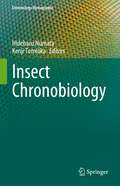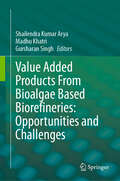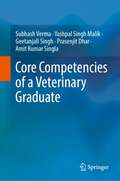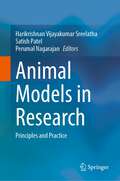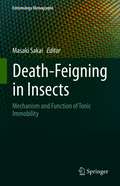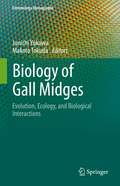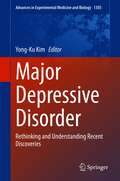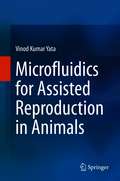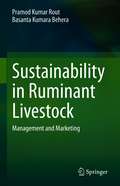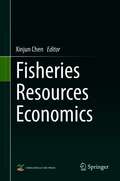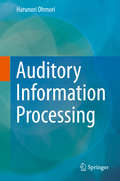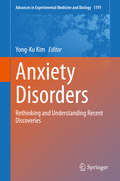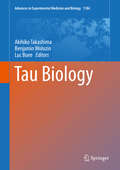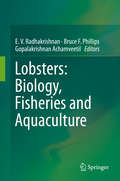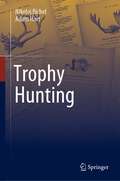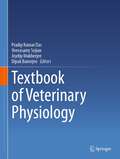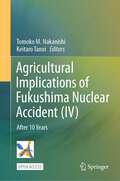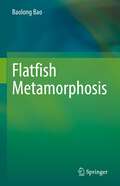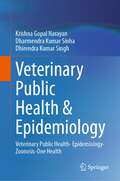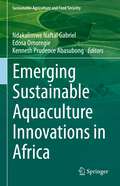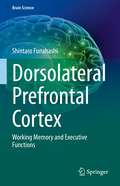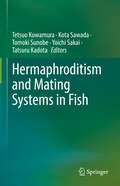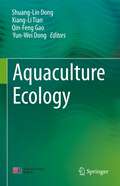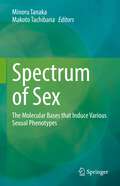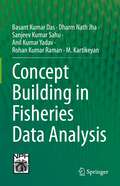- Table View
- List View
Insect Chronobiology (Entomology Monographs)
by Hideharu Numata Kenji TomiokaThis book reviews the physiological mechanisms of diverse insect clocks, including circadian clock, lunar clock, tidal clock, photoperiodism, circannual rhythms and others. It explains the commonality and diversity of insect clocks, focusing on the recent advances in their molecular and neural mechanisms. In the history of chronobiology, insects provided important examples of diverse clocks. The first report of animal photoperiodism was in an aphid, and the time-compensated celestial navigation was first shown in the honeybee. The circadian clock was first localized in the brain of a cockroach. These diverse insect clocks also have some common features which deserve to be reviewed in a single book. The central molecular mechanism of the circadian clock, i.e., the negative feedback loop of clock genes, was proposed in Drosophila melanogaster in the 1990s and later became the subject of the Nobel Prize in Physiology or Medicine in 2017. Thereafter, researches on the molecular and neural mechanisms in diverse insect clocks other than the Drosophila circadian clock also advanced appreciably. Various new methods including RNAi, NGS, and genome editing with CRISPR-Cas9 have become applicable in these researches. This book comprehensively reviews the physiological mechanisms in diverse insect clocks in the last two decades, which have received less attention than the Drosophila circadian clock. The book is intended for researchers, graduate students, and highly motivated undergraduate students in biological sciences, especially in entomology and chronobiology.
Value Added Products From Bioalgae Based Biorefineries: Opportunities and Challenges
by Shailendra Kumar Arya Madhu Khatri Gursharan SinghThis book covers wide aspects of algal technology and algae-based biorefinery aspects. Algae are the most prevalent, primitive, and abundant microbes on Earth, however, the commercialization of algal-based value-added products is still low due to the negligible dissemination of knowledge flow among the stakeholders and researchers.This book provides up-to-date information on the cultivation of microalgae, their harvesting, downstream processing, and diverse applications. It further discusses the macromolecules existing in microalgae, such as proteins, carbohydrates, and lipids, poly-unsaturated fatty acids, peptides, exo-polysaccharides, flavonoids and antioxidants. This book also highlights the advantages and some real-time challenges before the establishment of sustainable algal-based biorefineries. Further, it includes clear flow charts and figures in each chapter to aid in interpretation of every technical concept. This book motivates readers, entrepreneurs, and young farmers to exploit easily growing microalgae through cottage to large-scale biorefineries and start their own businesses for the production of value-added products.
Core Competencies of a Veterinary Graduate
by Subhash Verma Yashpal Singh Malik Geetanjali Singh Prasenjit Dhar Amit Kumar SinglaThis book is an essential guide for veterinarians, veterinary faculty and policymakers for understanding the core competencies of a fresh veterinarian. The book briefly covers competencies in preclinical, paraclinical, and clinical subjects including anatomy, physiology, biochemistry, veterinary jurisprudence, animal management & welfare including nutrition and breeding, infectious and non-infectious diseases, disease epidemiology, diagnosis, and treatment, prevention, control and zoonoses, surgical and other clinical interventions. The book further includes other competencies, including biologicals, anti-mortem, and post-mortem inspection, certifications, applied one health aspects, review and analysis of scientific evidence, international trade and regulations, and organization of veterinary services. It also highlights the importance of effective communication, interpersonal skills, record keeping and management of a small veterinary hospital, health informatics, etc. The book breakdowns the must-have competencies of a global veterinarian into different topics and subtopics for easy comprehension and further learning. It enables the professional standard-setting & regulatory bodies and academicians in improved curricula designing and implementation and more importantly tries to bring uniformity in day one veterinary graduates’ competencies globally, enhancing the movement and employability of veterinarians across the world.
Animal Models in Research: Principles and Practice
by Harikrishnan Vijayakumar Sreelatha Satish Patel Perumal NagarajanThis book describes the development of animal models widely used in biomedical research using step-wise instructions and photographs. Showcasing a wide range of species from zebra fishes, birds, rodents, rabbits, dogs, and pigs, the book includes detailed methodology on how to work with these species and to develop various models. The animal models in neurology including stroke, Alzheimer’s disease, Parkinson’s disease, and Schizophrenia; Animal models in cancer research, sleep disorders, and cardiovascular diseases are described to meet the understanding of researchers who plan to replicate these models in their laboratories. In depth detailing on the development of targeted gene knockouts and transgenics, implantation models that are used in toxicology studies, and pharmacokinetic studies in pigs and dogs are a highlight. Further, the book describes pharmacologic, chemically induced, surgically induced, microbiologically induced, infectious models, models for neurobehavioral studies, oncology research, and pain research. The book has dedicated sections on anesthesia and analgesia and teaches procedures like venous cut-downs and cannulations in pigs and dogs, and endotracheal intubation, mechanical ventilation and thoracotomy in rodents and will serve as a self-training tool. Concepts in the field of animal model development are explained using examples. Sample size selection, study design, and statistical evaluation of experiments involving laboratory animals are explained to enable young researchers to practically understand the nuances. This book will be a valuable tool for academicians, students, scientists, and veterinarians and will benefit equally who are new to the field and who are already working with laboratory animals.
Death-Feigning in Insects: Mechanism and Function of Tonic Immobility (Entomology Monographs)
by Masaki SakaiThis book examines the mechanisms and functions of tonic immobility, the so-called death feigning behavior, or thanatosis, or animal hypnosis. The chapters cover the neurophysiological and experimental studies on insects, the functional significance of death-feigning, examination of the freezing and immobility behavior in insects through environment, physiology, genetics, and responses to ultrasound and vibration. It also covers tonic immobility and freezing behavior in fish from the perspective of vertebrates study.Tonic immobility is an interesting behavior that occurs reflexively in various animals under physical restraint by predators. The physiological mechanism of thanatosis was extensively investigated during 1960-1980. Researchers have proposed hypotheses to explain the mechanism underlying tonic immobility in vertebrates; local inhibition of the central nervous system, acceleration of the limbic system, abnormal control of the autonomic nervous system. On the other hand, the peripheral and central mechanisms of tonic immobility were intensely investigated at a behavioral and a neuronal level in stick insects and crickets. In the 1970s, behavioral ecology has shed light on the aspect of an ultimate factor for tonic immobility. Ethologists and ecologists challenged this matter in the laboratory and natural habitats, and have collected evidence for its functional roles using mainly insects such as beetles, moths, locusts. More recently, studies of tonic immobility in humans are drawing attention, as clinicians are trying to explain the defencelessness of rape victims from the viewpoint of animal hypnosis.This timely publication provides an understanding of the past and present research of the mechanisms and functions of tonic immobility. This book is intended for researchers and undergraduate/ graduate students in the field of zoology including physiology, ethology, ecology, and human behavior. It will also appeal to the public audience who has an interest in animal behavior, including human behavior.
Biology of Gall Midges: Evolution, Ecology, and Biological Interactions (Entomology Monographs)
by Junichi Yukawa Makoto TokudaThis book provides practical ecological, ethological, evolutionary, and biogeographic data for gall-inducing cecidomyiids, their galls and host plants, based on field surveys, laboratory experiments and genetic analysis. It refers to various researches on gall-inducing insects published by a world of biologists. Practical methods of field surveys and data analysis are presented, as well as topics on parasitoids, invasive pests, and beneficial gall midges that would be useful for applied entomologists. Readers can learn an ecological way of thinking through diverse interrelations between insects and plants, and the analysis of ecological data from gall-inducing cecidomyiids. Galls can be easily observed in the field continuously from early to final stage of the development of galls and gall inducers because of their outstanding features and immobility. It provides important data of the host plant such as phenology, abundance as food resources, and the survival of galled organs. By taking these advantages, many biologists have used galls and gall-inducing insects as highly convenient organisms for a wide range of studies including ecology, ethology, evolution, and biogeography. The book primarily intends to present the appeal of galls and gall-inducing insects for various biological studies. In particular, gall-inducing cecidomyiids are ideal insects to study ecology and evolution. It helps to open the doors to further cryptic study subjects. Also, integrating various ecological, ethological, evolutionary and biogeographic data as shown in this book can serve to further advance the macroevolutionary studies of insects.
Major Depressive Disorder: Rethinking and Understanding Recent Discoveries (Advances in Experimental Medicine and Biology #1305)
by Yong-Ku KimThis book reviews all aspects of major depressive disorder (MDD), casting light on its neurobiological underpinnings and describing the most recent advances in management. The book is divided into four sections, the first of which discusses MDD from a network science perspective, highlighting the alterations in functional and structural connectivity and presenting insights achieved through resting state functional MRI and the development of neuroimaging-based biomarkers. The second section examines important diagnostic and neurobiological issues, while the third considers the currently available specific treatments for MDD, including biofeedback, neurofeedback, cognitive behavioral therapy, acceptance and commitment therapy, neuromodulation therapy, psychodynamic therapy, and complementary and alternative medicine. A concluding section is devoted to promising emerging treatments, from novel psychopharmacological therapies through to virtual reality treatment, immunotherapy, biomarker-guided tailored therapy, and more. Written by leading experts from across the world, the book will be an excellent source of information for both researchers and practitioners.
Microfluidics for Assisted Reproduction in Animals
by Vinod Kumar YataThis book describes the fundamentals of microfluidics and fabrication methods of microfluidic devices that can be adopted for animal-assisted reproduction. It presents microfluidic methods for sorting highly fertile spermatozoa. This book also describes the application of microfluidics in vitro fertilization and embryo culture. It discusses the use of microfluidics in sperm sexing and the cryopreservation of animal gametes and embryos. Lastly, the book examines the potential opportunities of microfluidics in infertility diagnosis, sperm selection and guidance, oocyte selection, insemination, and embryo monitoring.
Sustainability in Ruminant Livestock: Management and Marketing
by Pramod Kumar Rout Basanta Kumara BeheraThis book presents a concept for implementing a mass balance approach toward developing an effective eco-friendly, livestock farming system independent of external energy input. In this context it describes a modern, integrated farming system, and includes comprehensive technical information explaining the design and evaluation of manure management systems, and modeling and operational tools. It first discusses the mass balance operating process, highlighting the difference between imported and exported mass across the farm boundary. Estimating mass balance can provide critical information for (comprehensive) nutrient management planning and for managing the movement of nutrients and manure. It then explains the estimation of whole-farm P mass balance using a suitable model system. The subsequent chapters provide updated information on management aspects of livestock-farming and generation of multiple job opportunities, and also explore various aspects of livestock farming operational protocols like housing and management; nurture of rams, ewes and lambs, new born calves and heifers; care of buck, doe and kid- nutrition flushing; concept zero grazing-systems; disease control and management; integrated goat farming; and crop-livestock integration. Further, the book addresses crop-livestock integration; energy autonomy in cattle farming; value added biopharmaceuticals from cattle farming; CAPEX for cattle farming; concepts of cattle farming; detrimental effects of the industry; topographic and edaphic factors, and thermal stress on livestock growth and development; socioeconomic development; and water requirements for livestock. The book concludes with the most important issue in the field of agriculture and veterinary science: “Livestock Farming with Care,” describing sustainable, eco-friendly livestock farming by highlighting issues like animal feed vs. human food; agricultural GDP vs livestock, and factors affecting the sustainability of livestock farming. Given its scope, this book is a valuable resource for researchers and students alike, and will also appeal to practitioners in the field of livestock.
Fisheries Resources Economics
by Xinjun ChenFisheries resources are an important component of natural resources. It is an important source of high-quality animal protein and food for humans, which provides employment, economic benefits and social welfare for people engaged in fishing activities. It also has played an important role in food safety, economic development, and foreign trade. Fisheries resources economics is an important branch of both applied economics and resource economics. Its research object is fishery resources and its economic problems. The economics of fishery resources is to focus on the relationship between the demand for human economic activities and the supply of fishery resources, as well as between fishery resources and its development. This book expounds the reasons for the economic problems of fishery resources and the theoretical principles for solving them, so as to reveal the objective rules of the allocation of fishery resources in different regions and at different times, to coordinate the relationship between the utilization of fishery resources and economic development, and to realize the sustainable development of fishery economy. This book will also provide learning materials for undergraduates, graduate students and practitioners engaged in fishery resources development and scientific management.
Auditory Information Processing
by Harunori OhmoriThis book explains neural function at the level of ion channels and membrane excitability in neurons along the ascending auditory pathway. Airborne sound information is captured by the ears, transformed to neural electrical signals, and then processed in the brain. Readers will find full descriptions of these processes of signal transduction and transformation. First, it is described how, at the level of hair cells, the receptor cells in the cochlea, the sound-evoked vibration is transduced to electrical signals and transmitted to the auditory nerve fibers. In the second section it is explained how the electrical activity of these fibers is processed at the cochlear nucleus in order to extract the temporal and level information of sound separately and then transmitted to the third nucleus for processing of the interaural differences, such as the interaural time difference and the interaural level difference. The third section summarizes the transformation of auditory temporal information to the rate of neural firing activity in the midbrain and the higher nuclei, including the cortex, based on in vivo results. Finally, emerging new technologies to investigate auditory signal processing are reviewed and discussed.
Anxiety Disorders: Rethinking and Understanding Recent Discoveries (Advances in Experimental Medicine and Biology #1191)
by Yong-Ku KimThis book reviews all important aspects of anxiety disorders with the aim of shedding new light on these disorders through combined understanding of traditional and novel paradigms. The book is divided into five sections, the first of which reinterprets anxiety from a network science perspective, examining the altered topological properties of brain networks in anxiety disorders. The second section discusses recent advances in understanding of the neurobiology of anxiety disorders, covering, for example, gene-environmental interactions and the roles of neurotransmitter systems and the oxytocin system. A wide range of diagnostic and clinical issues in anxiety disorders are then addressed, before turning attention to contemporary treatment approaches in the context of novel bio-psychosocial-behavioral models, including bio- and neurofeedback, cognitive behavioral therapy, neurostimulation, virtual reality exposure therapy, pharmacological interventions, psychodynamic therapy, and CAM options. The final section is devoted to precision psychiatry in anxiety disorders, an increasingly important area as we move toward personalized treatment.Anxiety Disorders will be of interest for all researchers and clinicians in the field.
Tau Biology (Advances in Experimental Medicine and Biology #1184)
by Akihiko Takashima Benjamin Wolozin Luc BueeThis book presents essential studies and cutting-edge research results on tau, which is attracting increasing interest as a target for the treatment of Alzheimer's disease. Tau is well known as a microtubule-associated protein that is predominantly localized in the axons of neurons. In various forms of brain disease, neuronal loss occurs, with deposition of hyperphosphorylated tau in the remaining neurons. Important questions remain regarding the way in which tau forms hyperphosphorylated and fibrillar deposits in neurons, and whether tau aggregation represents the toxic pathway leading to neuronal death. With the help of new technologies, researchers are now solving these long-standing questions. In this book, readers will find the latest expert knowledge on all aspects of tau biology, including the structure and role of the tau molecule, tau localization and function, the pathology, drivers, and markers of tauopathies, tau aggregation, and treatments targeting tau. Tau Biology will be an invaluable source of information and fresh ideas for those involved in the development of more effective therapies and for all who seek a better understanding of the biology of the aging brain.
Lobsters: Biology, Fisheries and Aquaculture
by E. V. Radhakrishnan Bruce F. Phillips Gopalakrishnan AchamveetilThis book is an important addition to the knowledge of lobster research. The book complements other books published on lobster research and management as it focuses on Indian lobster fisheries and aquaculture developments where there have been nearly 350 research papers and reports and 19 PhD awards. The book has 15 chapters written by international experts covering many aspects of the biology of a number of spiny and slipper lobster species occurring in India and world oceans with maps illustrating global distribution of spiny lobster families, genera and species. An updated taxonomy and checklist of marine lobsters, the status and management of lobster fisheries in India and Indian Ocean Rim countries and a review of aquaculture research in India and other major countries have also been presented. The book is timely as the 2nd International Indian Ocean Expedition (IIOE) is currently underway (2015-2020), 50 years after the original IIOE (1959-1965), with some of the original lobster research on the biology and distribution of phyllosoma larvae being undertaken on the plankton samples collected during the first IIOE. Many of the chapters are contributed by the authors from Central Marine Fisheries Research Institute (CMFRI), which has been collecting fishery and biological data on lobsters since 1950 when lobster fishing began on a subsistence scale, followed by some industrial fishing for lobsters in different parts of India. Unfortunately, the development of some of these lobster fisheries was followed by overfishing due to lack of enforcement of regulations. The book provides a valuable addition to our knowledge of the biology, fisheries and aquaculture of spiny and slipper lobsters.
Trophy Hunting
by Nikolaj Bichel Adam HartThis book gets to the heart of trophy hunting, unpacking and explaining its multiple facets and controversies, and exploring why it divides environmentalists, the hunting community, and the public. Bichel and Hart provide the first interdisciplinary and comprehensive approach to the study of trophy hunting, investigating the history of trophy hunting, and delving into the background, identity and motivation of trophy hunters. They also explore the role of social media and anthropomorphism in shaping trophy hunting discourse, as well as the viability of trophy hunting as a wildlife management tool, the ideals of fair chase and sportsmanship, and what hunting trophies are, both literally and in terms of their symbolic value to hunters and non-hunters. The analyses and discussions are underpinned by a consideration of the complex moral and practical conflicts between animal rights and conservation paradigms. This book appeals to scholars in environmental philosophy, conservation and environmental studies, as well as hunters, hunting opponents, wildlife management practitioners, and policymakers, and anyone with a broad interest in human–wildlife relations.
Textbook of Veterinary Physiology
by Pradip Kumar Das Veerasamy Sejian Joydip Mukherjee Dipak BanerjeeThis textbook explores the fundamental qualitative and quantitative aspects of veterinary physiology. It presents the morphological description of the organs, tissues, and cells involved in the physiological system with species variation. The book provide the most up-to-date information and in depth knowledge in animal physiology. The book addresses a broad range of topics, including the physiology of digestion in, monogastric animals, ruminants, and birds, and cardio vascular and respiratory system in different animals. The chapters contain a wealth of information on the areas related to the endocrine system, excretory system, body fluid homeostasis, hematology, male and female reproductive systems, coordination of body functions, and regulation of brain functions and sense organs. Further, this book acquaints students with advanced topics like immune system, assisted reproductive technology, ovarian dynamics, environmental physiology and thermoregulation, and behavioral physiology. This textbook contains clear illustrations including graphical abstracts and study questions for each chaptermaking this book a valuable learning resource for veterinary sciences and veterinary medicine students.Further to attract students and create interest in them, interesting facts related to animal physiology have also been highlighted in form of “Know more widges”.
Agricultural Implications of Fukushima Nuclear Accident (IV): After 10 Years
by Tomoko M. Nakanishi Keitaro TanoiThis open access book presents the findings from on-site research into radioactive cesium contamination in various agricultural systems affected by the Fukushima Daiichi Nuclear Power Plant accident in March 2011. This fourth volume in the series reports on studies undertaken at contaminated sites such as farmland and forests, focusing on soil, water, mountain, agricultural products, and animals. It also provides additional data collected in the subsequent years to show how the radioactivity levels in agricultural products and their growing environments have changed with time and the route by which radioactive materials entered agricultural products as well as their movement between different components (e.g., soil, water, and trees) within an environmental system (e.g., forests). The book covers various topics, including radioactivity testing of food products; decontamination trials for rice and livestock production; the state of contamination in, trees, mushrooms, and timber; the dynamics of radioactivity distribution in paddy fields and upland forests; damage incurred by the forestry and fishery industries; and the change in consumers’ attitudes. In the series of this book, a real-time radioisotope imaging system has been introduced, a pioneering technique to visualize the movement of cesium in soil and in plants. This is the only book to provide systematic data on the actual change of radioactivity, which is of great value to all researchers who wish to understand the effect of radioactive fallout on agriculture. In addition, it helps the general public better understand radio-contamination issues in the environment. The project is ongoing; the research groups from the Graduate School of Agricultural and Life Sciences of The University of Tokyo continue their work in the field further to evaluate the long-term effects of the Fukushima accident.
Flatfish Metamorphosis
by Baolong BaoThis book provides a comprehensive discussion of the development and evolution of flatfish metamorphosis. The chapters use the tissue model to explain a series of metamorphic events, including eye migration, front bone deformation, dorsal fin elongation and regression, and body depth change, left/right asymmetrical pigmentation, give a hypothesis on the mechanism of eye migration, and the evolutionary origin of left/right eye asymmetry. The book is written by expert who has worked on flatfish metamorphosis over 20 years. It serves as a valuable reference for graduate students and researchers in related fields
Veterinary Public Health & Epidemiology: Veterinary Public Health- Epidemiology-Zoonosis-One Health
by Krishna Gopal Narayan Dharmendra Kumar Sinha Dhirendra Kumar SinghThis book introduces and reviews the essential principles of Veterinary Public Health, Zoonoses, One Health, principles and applications of epidemiology in studying infectious diseases including foodborne infections and intoxications. The initial chapters discuss the concept and principal functions of Veterinary Public Health. The book further covers the impacts of Veterinary Public Health on human Health particularly in management of zoonoses. The following section discusses theapplication of epidemiology in the study of outbreaks, epidemic, pandemics and their prevention and control strategies. It helps understanding the factors associated with disease causation transmission and spread and also investigate the emergence of antimicrobial resistance. The chapter on foodborne illnesses illustrates how the knowledge of epidemiology is applied in the study of diseases in community, spread of causative agents from farm to fork. The definition, cause, symptoms, management, control and prevention of foodborne infection and intoxication are dealt with.The last chapter introduces the concept, objectives, and definition of One Health and discusses the advancements made and challenges in One Health around endemic and emerging zoonotic diseases.
Emerging Sustainable Aquaculture Innovations in Africa (Sustainability Sciences in Asia and Africa)
by Ndakalimwe Naftal Gabriel Edosa Omoregie Kenneth Prudence AbasubongThis edited book presents the emerging sustainable innovations in all areas of aquaculture in Africa with a view to create an opportunity whereby scientific outputs and recommendations can be endorsed for improved aquaculture outputs towards poverty alleviation and food security on the continent. Food insecurity and poverty are some of the challenges faced on the African continent. These challenges are further exacerbated by the growing human population and the impacts of climate change. Today, aquaculture has become one of the fastest food producing sectors in the world, with the potential to contribute significantly to food security and poverty alleviation in developing countries. In Africa, aquaculture is at an infant stage, however, many African countries have recognized the potential roles of aquaculture in food security, poverty alleviation and conservation of aquatic resources through their commitment to achieve the United Nation Sustainable Development Goals. The book reviews and synthesize research work from these thematic areas across Africa and provide a unique perspective on the emerging aquaculture innovations and illustrate how aquaculture practices could be feasible and cost effective while promoting social and environmental sustainability. The book also draws from global discussions on sustainable aquaculture practices and provides recommendations on what is feasible for Africa. This book is a great tool for the university students, scholars, aquaculture farmers, investors, and policymakers to understand the scientific based sustainable aquaculture innovations from an African perspective. This book is focused on SDG 2 and SDG 14.
Dorsolateral Prefrontal Cortex: Working Memory and Executive Functions (Brain Science)
by Shintaro FunahashiThe prefrontal cortex is known to play important roles for performing a variety of higher cognitive functions. Among regions of the prefrontal cortex, the dorsolateral prefrontal cortex plays the most important roles for these functions. This book focuses on functions of the dorsolateral prefrontal cortex, summarizes research results obtained mainly by non-human primate studies, and describes neural mechanisms of executive functions that the dorsolateral prefrontal cortex participates. First, to understand the feature of the dorsolateral prefrontal cortex and how its function has been understood, anatomical and functional features of the dorsolateral prefrontal cortex and historical overview of prefrontal functions are described. To understand functions of the prefrontal cortex and neural mechanisms of executive functions, working memory is an important concept and sustained activation during the memory period of working memory tasks is known as a neural mechanism of working memory. Therefore, this book describes features of sustained memory-related activity based on neurophysiological results obtained in the prefrontal cortex and how memory-related activity contributes to executive functions including control of attention, inhibitory control, task management, and planning. And further, this book describes how the dorsolateral prefrontal cortex contributes to neural mechanisms for sensory and motor processing, memory control in multi-task performance, decision-making, metacognition, and top-down control. Thus, this book provides important information regarding neural mechanisms of dorsolateral prefrontal functions to neuroscientists and helps to plan further investigation to understand prefrontal functions in primates and human subjects.
Hermaphroditism and Mating Systems in Fish
by Tetsuo Kuwamura Kota Sawada Tomoki Sunobe Yoichi Sakai Tatsuru KadotaThis book provides a comprehensive review of hermaphroditism in fishes. It focuses on the behavioral ecology of functional hermaphroditism in fishes and discusses its evolution.Approximately 99% of all vertebrate species consist of separate-sex individuals (gonochorists), i.e., pure males and pure females. The other 1% of vertebrate species are hermaphroditic, and almost all of them are fishes. Among hermaphroditic fishes, four major types of hermaphroditism are known: simultaneous (or synchronous) hermaphroditism, protandry (male-to-female sex change), protogyny (female-to-male sex change), and bidirectional sex change (or reversed sex change in protogynous species). The book examines the occurrence of hermaphroditism in relation to phylogeny and mating systems. It also reviews the hypotheses for the evolution of hermaphroditism, and the size-advantage model, which is the main theory for the evolution of sex change, tested in relation to the mating system. The appendix in the last chapter provides an annotated list of hermaphroditic fish species (ca. 500 spp.).
Aquaculture Ecology
by Shuang-Lin Dong Xiang-Li Tian Qin-Feng Gao Yun-Wei DongThis book introduces aquaculture ecology as a science of the interaction between commercial aquatic organisms as well as their farming activities and the environment, including the rationales of building and management of aquaculture systems. This book covers productivity and carrying capacity, effects of cyclical fluctuation of environmental factors on aquatic organisms, biological control of water quality, structural optimization of aquaculture systems and ecological prevention of disease. In the last chapter, aquaculture production systems are introduced from multiple perspectives.This book has been designed to provide a stimulating and informative text for researchers in aquaculture, fisheries as well as hydrobiology.
Spectrum of Sex: The Molecular Bases that Induce Various Sexual Phenotypes
by Minoru Tanaka Makoto TachibanaThis book introduces cutting-edge studies on the spectrum of sex. The sex spectrum can be understood as an interwoven mechanism sustaining graded phenotypes between the two sexes. The book overviews three elements that develop the sex spectrum: genetics, the endocrine system, and the environment. Part I discusses the genetic regulation during sex determination, which often results in a mixture of two sexes or sex reversal. The evolutionary aspects of the genetic determinants are also discussed. Part II presents the involvement of endocrine regulation in the sex spectrum, which covers a broad range of phenotypic events, including sexual behavior and metabolism. Interestingly, sex hormones can also act as sex determinants. Finally, Part III shows that intrinsic factors, such as sex-determining genes and sex hormones, are not the only factors in sex development. The environment surrounding organisms, such as symbiosis and metabolism, act on the sex as critical factors, generating the sex spectrum. Determination and development of the two sexes have been a topic of great interest and a long-standing issue in biology. The book updates the conventional view that biological sex is fixed after birth and sets new perspectives for understanding sex as a spectrum manifested in multiple phenomena. Each chapter contributed by leading experts explains the sex spectrum in various organisms and their underlying mechanisms from the latest ongoing studies. The book provides a valuable resource for not only experts in developmental biology, physiology, and medical science, but also non-scientists and anyone interested in the topic.
Concept Building in Fisheries Data Analysis
by Basant Kumar Das Dharm Nath Jha Sanjeev Kumar Sahu Anil Kumar Yadav Rohan Kumar Raman M. KartikeyanThis authored book is primarily for the readers who are in search of how to use basic concepts of statistics in the field of fishery science. It has been written for the new comers coming in the fishery sector including university students, teachers and research scholars. It enriches the reader’s knowledge of data analysis step by step starting from data collection to its analysis and interpretation along with practical application with real example. It supports readers for enhancing theoretical and practical concept of application of fundamental statistics in fishery domain. Reader may also learn how to analyses data using different statistical software. Each chapter starts with an introduction of the topic followed by statistical concept with example and ends with chapter based question for comprehension purpose. This book is of interest to teachers, researchers, scientists, capacity builders in fishery sciences. Also the book serves as additional reading material for undergraduate and graduate students of fisheries and aquatic sciences.
